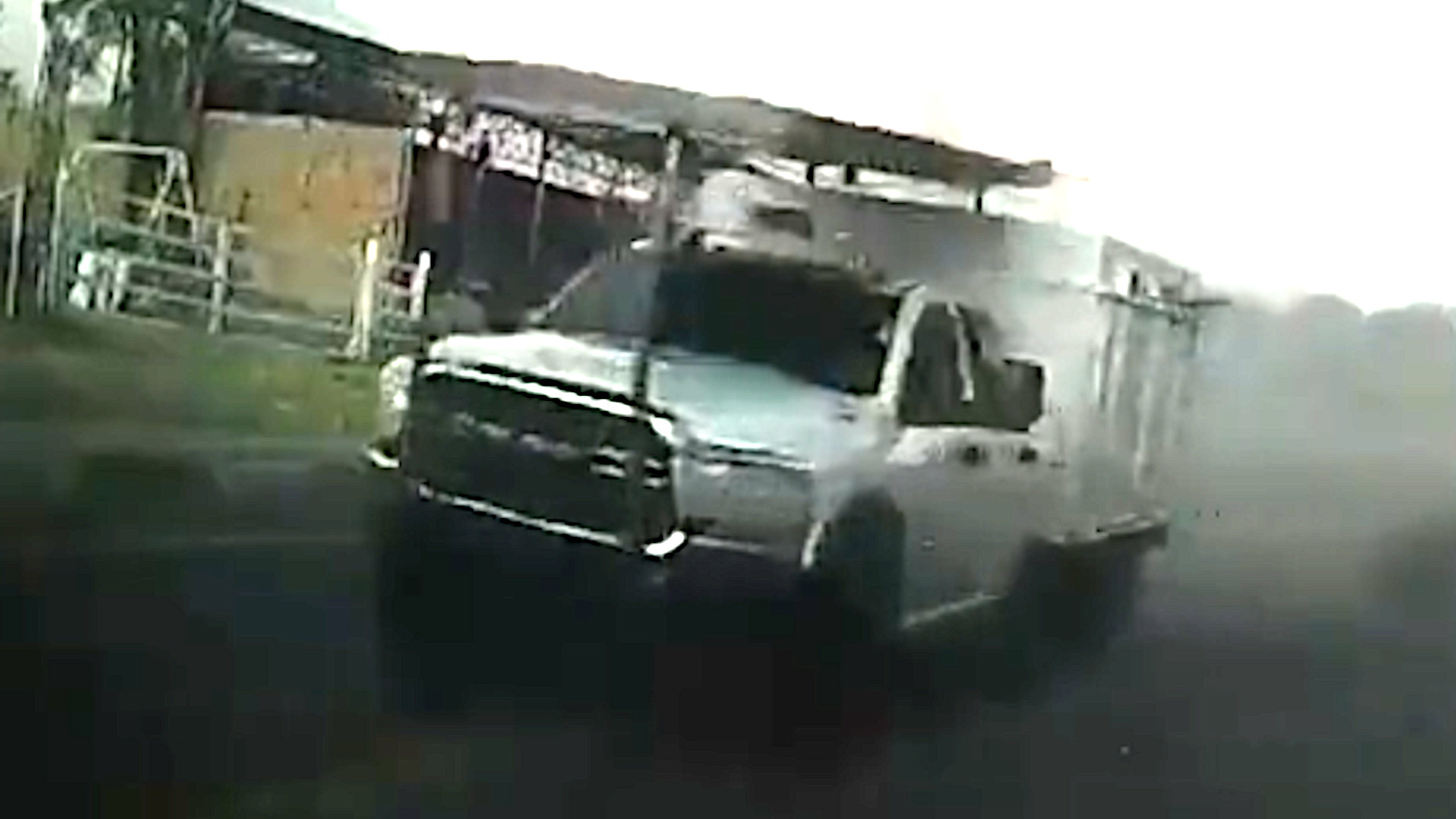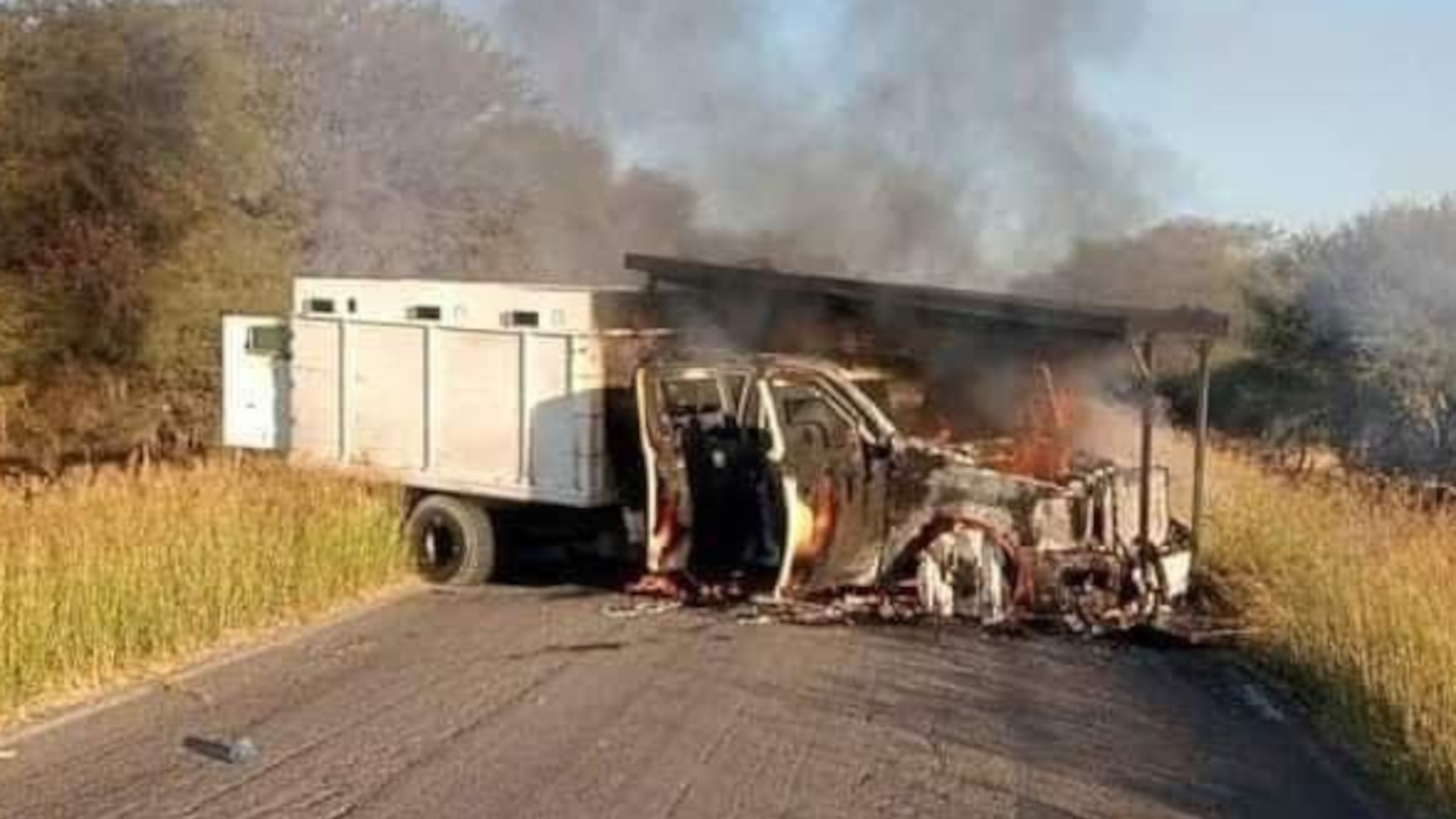A Mexican drug cartel recently employed an improvised armored truck, also commonly referred to as a “Narco Tank,” with what looks to be a metal screen over the front section of the vehicle. This is reminiscent of the so-called “cope cages” that have become a fixture on tanks and other armored vehicles on both sides of the conflict in Ukraine and that have also now emerged on Israeli tanks. These screens are primarily intended to provide extra protection against drones, something that cartels in Mexico are now regularly employing against government security forces and each other.
The Mexican vehicle in question was a modified Dodge Ram truck with a four-door cab that also had a box-like improvised armored structure at the rear with ports through which individuals inside could fire small arms. It was one of three Narco Tanks that took part in an ambush of Mexican military forces in the country’s state of Jalisco just over a week ago. The Cártel de Jalisco Nueva Generación (CJNG), or Jalisco New Generation Cartel, carried out the attack on November 19, which also reportedly involved the rapid establishment of roadblocks to hamper the arrival of government reinforcements.

At least three Mexican soldiers were killed and three other unspecified individuals were wounded, according to local media reports. The extent of any casualties among the cartel forces is unclear, but the Dodge Ram with the armor over the cab was destroyed in the course of the gunfight.
“The [November 19] incident is significant for the brazen nature of the CJNG attack upon the SEDENA [Secretaría de la Defensa Nacional, or Secretariat of National Defense] forces,” private California-based research and analysis firm C/O Futures noted in a monograph about the incident it published yesterday. However, “our interest is focused on the ‘cope cage’ welded to the one CJNG IAFV [improvised armored fighting vehicle] which was destroyed … and subsequently recovered by Federal authorities.”
Narco tanks, also referred to locally as “monstruos” (monsters in Spanish), have been a feature of Mexico’s drug wars for more than a decade now. The types that CJNG and other cartels use today are generally modified pickups, SUVs, and similar types of trucks. Before now, there does not appear to have been another example with any kind of “cope cage”-like armor over the cab and hood.
The social media posts below show more typical Narco Tank designs.
This kind of armor first appeared on Russian tanks in the lead-up to the invasion of Ukraine in 2022, but is now widely used on both sides of that conflict.
Israeli Merkava tanks with similar armored screens emerged following Hamas’ unprecedented terrorist attacks on October 7 and have since been employed in the Gaza Strip.
The actual effectiveness of the armored screens remains a subject of debate, and cope cage was originally coined as a derisive term. However, fighting in Ukraine has shown that screens like this are at least somewhat effective against drones, including certain types of loitering munitions, also known as kamikaze drones, and weaponized commercial types. They may also provide some modicum of extra protection against other kinds of top-down attacks, including those using infantry anti-armor weapons like rocket-propelled grenades or hand grenades.
At the same time, Ukrainian forces, in particular, have also demonstrated their ability to get drones in under and around this kind of armor. What are now known as “first-person view” (FPV) kamikaze drones, which are generally very maneuverable commercial quadcopter designs that carry improvised warheads, and that then smash directly into their targets and detonate, have proven to be especially useful for getting past cope cages.
What is perhaps more interesting about the CJNG Narco Tank with the armor over the front is that the Mexican government does not operate the kind of armed drones that screens like this are primarily designed to defeat.
“The cope cage extended over the cab and hood of the CJNG vehicle [is] to specifically protect it from opposing cartel drone weaponized drone strikes,” C/O Futures’ assessed. “It should be noted that Teocaltiche, Jalisco [where the November 19 ambush occurred] is a contested area between CJNG and Cártel de Sinaloa (CDS). Since April 2023, CDS has had weaponized drone aerial bombardment capability as it earlier ambushed a CJNG mobile element in Teocaltiche.”
Mexican drug cartels have increasingly been using weaponized commercial drones, including kamikaze types and ones designed to drop small improvised munitions, for years now, as The War Zone has reported on in the past. CJNG, which is known for being very well equipped and having organized military-style units, as can be seen in the video below, has been a pioneer of sorts for introducing uncrewed capabilities into Mexico’s drug wars.

“We began training as a group in 2021, but only this year we started operating,” an anonymous CJNG “Operadores Droneros,” or drone operator, told The Daily Beast for a story published earlier this year. “It depends on which drone we use, but we can be miles away and confirm that they [rivals] are at a certain house or vehicle and then crash the drone with the explosives.”
Cartels now routinely use drones to attack Mexican security forces and members of other cartels.
“So far this year, 260 such incidents [cartel drone attacks] have been recorded,” CBS News reported in August. “However, even that number may be an underestimate: residents in some parts of the western state of Michoacan say that attacks by bomb-dropping drones are a near-daily occurrence.”
Altogether, it is hardly surprising that a cope cage-equipped Narco Tank has now appeared in Mexico.
All of this, of course, also speaks to broader global trends in the use of weaponized drones, including commercial types, by non-state actors and nation-state militaries. The terrorist group ISIS is principally responsible for this, having demonstrated the utility of and low cost required to carry out such attacks. The group’s armed drone activities first really became apparent during the Battle of Mosul in Iraq between 2016 and 2017, as The War Zone drew attention to at the time.

Even unarmed drones offer various groups additional ways, and with a low barrier to entry, to surveil and harass their opponents. As uncrewed aerial systems, in general, have become a more common fixture on and off traditional battlefields, there has also been a surge in demand for ways to defend against them. As The War Zone has highlighted in the past, this remains an area where the U.S. military is still very much playing catchup.
“I’ve been in the Army for 38 years, and in my entire time in the Army on battlefields in Iraq, in Afghanistan, Syria, I never had to look up,” now-retired U.S. Army Gen. Richard Clarke, then head of U.S. Special Operations Command, explained during a talk at the annual Aspen Security Forum in 2022. “I never had to look up because the U.S. always maintained air superiority and our forces were protected because we had air cover. But now with everything from quadcopters – they’re very small – up to very large unmanned aerial vehicles [UAV], we won’t always have that luxury.”
“The cost of entry into this, particularly for some of the small unmanned aerial systems, is very, very low,” he continued. “I think that this is something that’s gotta continue to go up in terms of our priority for the protection, not just of our forces that are forward today – that’s the current problem – but what’s gonna come home to roost. Some of these technologies could be used by our adversaries on our near abroad or even into our homeland.”
No matter what the exact degree of protection cope cage-type armor actually provides, the appearance of what very much looks to be a Mexican Narco Tank outfitted in this way underscores just how serious and widespread the Cartel drone threat has become in that country. The improvised armored truck seen in Jalisco also points to this kind of anti-drone protection for vehicles becoming increasingly commonplace around the world.
Contact the author: joe@thedrive.com
